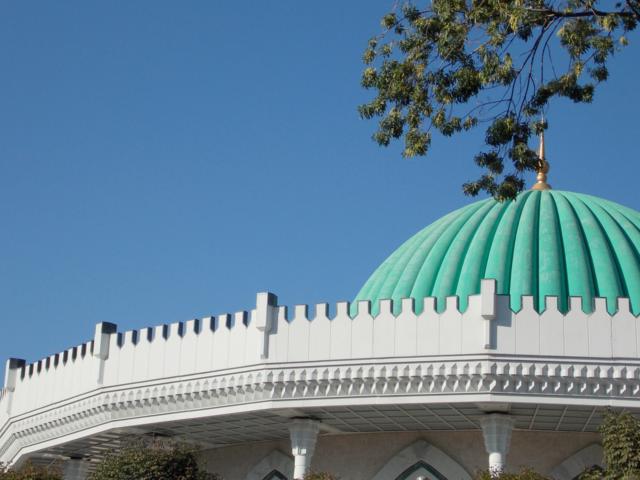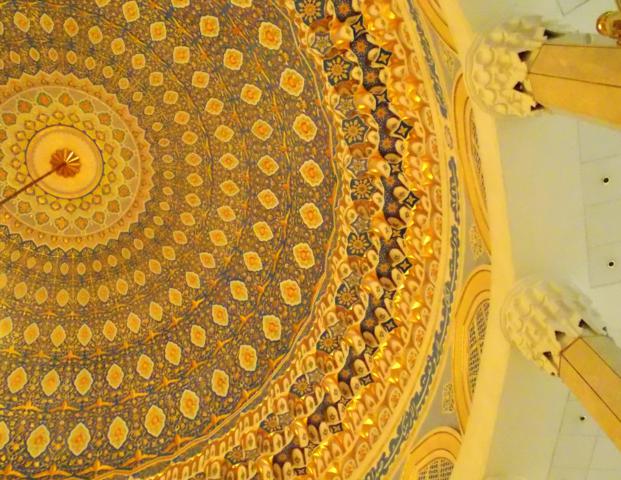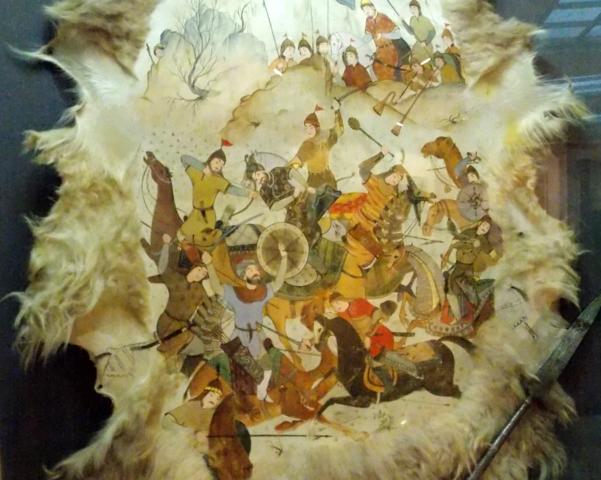Timur cel Mare sau Tamerlan, cum este cunoscut in vest, s-a nascut in 1336 langa Samarkand, in Kesh, ca fiu al unui sef de trib. Numele sau turcic Timur, inseamna “fier”. Legenda spune a fost ranit de o sageata in tinerete si a ramas schiop, de unde si numele de Tamerlan (persanul Timur-i-lang). Ajuns conducatorul Samarkandului, pe care l-a facut capitala sa, si-a alcatuit o armata puternica cu care a inceput sa-si puna in practica politica anexionista, construind un imperiu (1370-1405), care s-a intins intre Delhi si Moscova si intre Muntii Thien Shan si Taurus, in Anatolia.
Infatisarea sa a fost reconstituita de catre savantul sovietic Gerasimov, in 1941, pe baza studierii scheletului sau. Era inalt, bine construit, cu un cap mare si o frunte lata. Contemporanii sai il descriu ca avand o voce puternica, barba lunga si ten palid.Se proclama urmas direct al lui Genghis Han dar nu s-a putut dovedi acest lucru. Puterea sa se baza atat pe triburile loiale familiei sale, cat si pe soldati recrutati din triburi nomade. Fie ca erau musulmani sau crestini, uriasa sa armata numara tadjici, arabi, turci, georgieni, indieni, integrati cu totii intr-un sistem institutional unic.Ultima sa campanie, cea de cucerire a Chinei, la aproape 70 de ani, i-a adus moartea – pe drum – inante de a ajunge pe campul de lupta. A murit in 1405 si a fost inmormantat in Mausoleul Gur-i-Mir din Samarkand. Dintre urmasii sai, mai cunoscuti pentru noi sunt nepotul sau Ulugbek – astronom, matematician si…sultan si Babur, care in 1527 a intemeiat in India dinastia baburida, cunoscuta sub numele de Marele Imperiu Mogul.Timur iubea arta si a lasat in urma sa o multime de constructii: moschei, madrase, mausolee, care i-au intarit si legaturile cu liderii religiosi ai vremii. In acest scop a invitat cei mai buni mestesugari din Iran, India, Azerbaidjan si Khorezm. Cateva dintre cele mai vestite constructii: Moscheea Juma, Mausoleul Gur-i-Emir si ansamblul Shahi Zinda din Samarkand si Mausoleul Chasma-Ayub din Bukhara, le-am vizitat si noi.
In 1996, cu ocazia celei de-a 660-a aniversari a lui Amir Timur, a fost construit in Tashkent Muzeul Timurizilor sau Muzeul lui Amir Timur. Este o cladire remarcabila, de forma rotunda, acoperita cu un dom caracteristic arhitecturii locale. Coridorul (“aywan”) deschis se sprijina pe coloane care pun in evidenta ferestrele cu arcuri, impodobite cu majolica albastra.
Muzeul Timurizilor
reflectie
In interior, bolta imensa, pictata, a domului este impodobita cu foita de aur (20 kg). Un candelabru cu 106000 cristale si inaltimea de 8.5 m (produs in Tashkent) straluceste, la propriu si la figurat, accentuind eleganta si bogatia interiorului.
Inscriptiile caligrafice de pe pereti simbolizeaza principii de viata. Exponatele sunt mai ales picturi si desene infatisand viata lui Timur, diferiti reprezentanti ai dinastiei dar si viata de zi cu zi sau a armatei. De asemenea, mai sunt expuse monezi, arme, manuscrise, costume vechi. Chiar in centru, o fresca imensa infatiseaza aspecte din viata lui Timur. In fata sa, in mijlocul salii, este asezata o copie a Coranului lui Osman, despre care voi povesti mai tarziu.
Timur, pe tron
copia Coranului lui Osman
Ulugbek in observatorul sau
Timur, reintorcandu-se in oras
La intoarcere, am dorit sa revedem cladirea muzeului, asa ca am revenit in zona, seara. Fantanile care il impodobesc in exterior, de data aceasta functionau.
On the Silk Road in Uzbekistan 7. Museum of the Timurids’ History
Timur the Great or Tamerlan, how he is known in the western world, was born on 1336 in Kesh, near Samarkand, as a son of a tribe chief. His pretention to be a direct descendant of Genghis Han was never proofed. His name means “iron”. When he became the leader of Samarkand, making it his capital, he organized a huge army and started to conquer the world. His empire stretched from Delhi to Moscow and from the Tien Shan Mountains to the Taurus Mountains, in Anatolia.
The soviet scientist Gerasimov reconstructed his image, after studying his skeleton, on 1941. Timur was a tall person, wellbuilt, with a big head and tall forehead. His contemporaries describe him as having a strong voice, pale complexion, a long beard.
His last campaign, against China, brought him his death, at nearly 70 years. He was burried in the Gur-i-Mir Mausoleum in Samarkand. Among his descendants, we know better Ulugbek, his grandson, who was an astronomer, mathematician and…sultan, and Babur, who conquered India on 1527, starting the baburids dynasty known as the “Great Moghul Empire”.
Timur loved arts and left a series of renowned constructions like: Gur-i-Mir Mausoleum, Juma Mosque and Shahi Zinda Complex in Samarkand, and Chasma-Ayubin Bukhara. We visited all these wonders.
On 1996, celebrating his 660thanniversary, a special museum was built, Timurids’History Museum or the Museum Amir Timur. The building is a round one, covered by a blue traditional dome. The columns inside and outside are traditional style. Twenty kilos of gold leaflets were used to ornate the painted ceiling. The 8.5 m tall chandelier was made in Tashkent. The interior is both elegant and opulent in sight. There are mainly paintings and miniatures but also coins, manuscripts, and weapons.
When we came back to Tashkent, we wanted to see the building again. This time, the fountains which adorn the exterior, were functioning.




WOW….these are again so fantastic…..thanks for all the great pictures.
Greetings, Joop
Thanks, Joop, for reading this!
These are wonderful. I really like the fountain.
Thank you, Randy!
I don’t know anyone else who travels to such fascinating places as you TH. What a fantastic palace of a museum! I like that you have night shots of the same setting, to show the different moods. Just an amazing presentation!
A very exotic place…
Thanks a lot, Doug, I take it as a compliment!
It was very nice, VP, to have so many paintings, miniatures, manuscripts, etc. about a dynast, together, under the same roof.
What a beautiful post Traveling Hawk! A beautiful building with a dome prachtgie. Really beautiful detaisl and the inside, you also have very nice mapped. Your quality is also very high. Really great class!
Greetings, Helma
Thank you, Helma, you are too kind!
Nu stiu prea multe despre dinastia Timurizilor, dar asta-i farmecul unei calatorii in tari departate, sa afli lucruri noi despre civilizatii mai putin cunoscute. Foarte frumoasa cladirea si fotografiile tale
Multumesc, Dani! Intr-adevar, cu ocazia acestei excursii am aflat o sumedenie d elucruri noi, mai ales despre istorie si islamism.
Fit for royalties. Majestic place, even the decors are very queenly.
Hi, Rizalenio! Glad “to hear” you again!
such a beautiful museum. i love the attention to detail. thanks for sharing.
I thank you for your comment!
Beautiful photos!
Timur conquest story is really interesting.
And I’m happy to see his portrait.
His beard,his clothes are impressive.
Thank you for sharing these wonderful photos:)
It’s a small but very nice museum, Kumiko. Thanks for the visit!
Îmi aduce aminte de Muzeul Artei Islamice din Doha, Qatar.